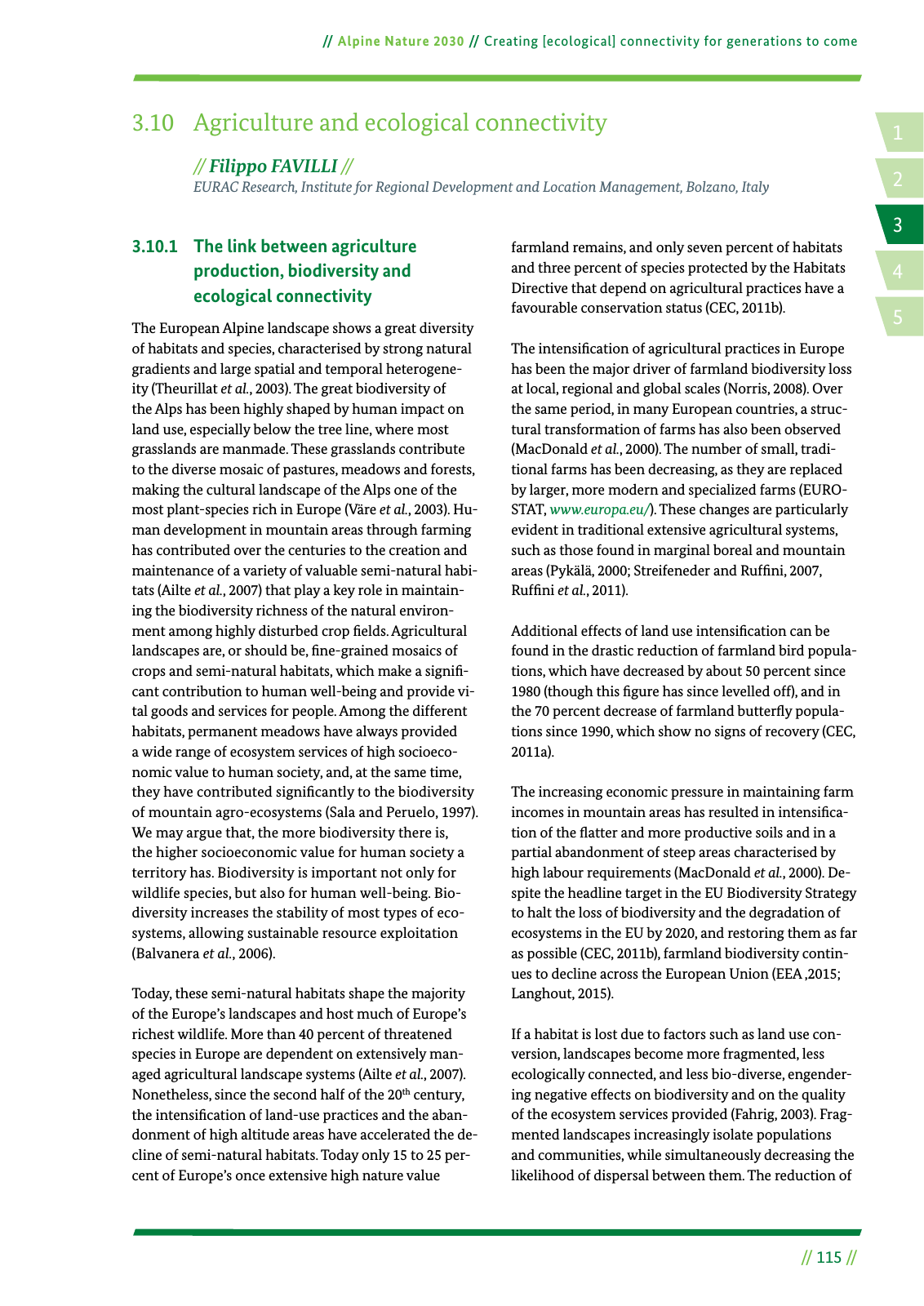14 2 5 3 Alpine Nature 2030 Creating ecological connectivity for generations to come 115 3 10 1 The link between agriculture production biodiversity and ecological connectivity The European Alpine landscape shows a great diversity of habitats and species characterised by strong natural gradients and large spatial and temporal heterogene ity Theurillat et al 2003 The great biodiversity of the Alps has been highly shaped by human impact on land use especially below the tree line where most grasslands are manmade These grasslands contribute to the diverse mosaic of pastures meadows and forests making the cultural landscape of the Alps one of the most plant species rich in Europe Väre et al 2003 Hu man development in mountain areas through farming has contributed over the centuries to the creation and maintenance of a variety of valuable semi natural habi tats Ailte et al 2007 that play a key role in maintain ing the biodiversity richness of the natural environ ment among highly disturbed crop elds Agricultural landscapes are or should be ne grained mosaics of crops and semi natural habitats which make a signi cant contribution to human well being and provide vi tal goods and services for people Among the different habitats permanent meadows have always provided a wide range of ecosystem services of high socioeco nomic value to human society and at the same time they have contributed signi cantly to the biodiversity of mountain agro ecosystems Sala and Peruelo 1997 We may argue that the more biodiversity there is the higher socioeconomic value for human society a territory has Biodiversity is important not only for wildlife species but also for human well being Bio diversity increases the stability of most types of eco systems allowing sustainable resource exploitation Balvanera et al 2006 Today these semi natural habitats shape the majority of the Europe s landscapes and host much of Europe s richest wildlife More than 40 percent of threatened species in Europe are dependent on extensively man aged agricultural landscape systems Ailte et al 2007 Nonetheless since the second half of the 20th century the intensi cation of land use practices and the aban donment of high altitude areas have accelerated the de cline of semi natural habitats Today only 15 to 25 per cent of Europe s once extensive high nature value farmland remains and only seven percent of habitats and three percent of species protected by the Habitats Directive that depend on agricultural practices have a favourable conservation status CEC 2011b The intensi cation of agricultural practices in Europe has been the major driver of farmland biodiversity loss at local regional and global scales Norris 2008 Over the same period in many European countries a struc tural transformation of farms has also been observed MacDonald et al 2000 The number of small tradi tional farms has been decreasing as they are replaced by larger more modern and specialized farms EURO STAT www europa eu These changes are particularly evident in traditional extensive agricultural systems such as those found in marginal boreal and mountain areas Pykälä 2000 Streifeneder and Ruf ni 2007 Ruf ni et al 2011 Additional effects of land use intensi cation can be found in the drastic reduction of farmland bird popula tions which have decreased by about 50 percent since 1980 though this gure has since levelled off and in the 70 percent decrease of farmland butter y popula tions since 1990 which show no signs of recovery CEC 2011a The increasing economic pressure in maintaining farm incomes in mountain areas has resulted in intensi ca tion of the atter and more productive soils and in a partial abandonment of steep areas characterised by high labour requirements MacDonald et al 2000 De spite the headline target in the EU Biodiversity Strategy to halt the loss of biodiversity and the degradation of ecosystems in the EU by 2020 and restoring them as far as possible CEC 2011b farmland biodiversity contin ues to decline across the European Union EEA 2015 Langhout 2015 If a habitat is lost due to factors such as land use con version landscapes become more fragmented less ecologically connected and less bio diverse engender ing negative effects on biodiversity and on the quality of the ecosystem services provided Fahrig 2003 Frag mented landscapes increasingly isolate populations and communities while simultaneously decreasing the likelihood of dispersal between them The reduction of 3 10 Agriculture and ecological connectivity Filippo FAVILLI EURAC Research Institute for Regional Development and Location Management Bolzano Italy

Hinweis: Dies ist eine maschinenlesbare No-Flash Ansicht.
Klicken Sie hier um zur Online-Version zu gelangen.
Klicken Sie hier um zur Online-Version zu gelangen.